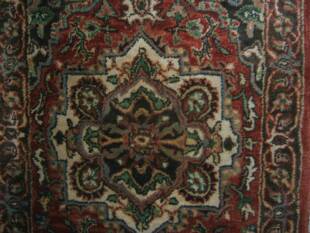




I am looking at the colors of a rug that my wife and I have that covers our carpet behind the sofa, facing the dining table in our home. Its rich colors of maroon, navy blue, rose and gold speak of royalty and warmth. Anyone can purchase one or numerous rugs for one’s home today without spending a lot of money; in fact one can buy many of them at a discount periodically, particularly when an oriental rug showroom is having a going out of business sale.
These fine coverings for our floors however at one time were not so easy to acquire or affordable to purchase. Once upon a time, in the late 1300’s when this industry began really flowering in Europe, only the royalty could afford them. While oriental rugs were made in Asia, India, the Arabian or Balkan peninsulas, the art form in Europe has been referred to as tapestry. Many of them depicted Biblical or mythological scenes. One series of four tapestries which were on display at Southern Methodist University’s Meadows Museum until May 13, depicted the 15th century conquest of Morocco by Afonso V. These were referred to as the Pastrana Tapestries. My wife and I viewed them one Thursday evening in April and I was impressed enough to decide to write an article about tapestries.
In the 15th century, many tapestries were woven in Belgium and the Netherlands, in cities such as Flanders. Other towns such as Oudenaarde, Brussels, Geraardsbergen and Enghien also became the centers of European tapestry production. One key city for tapestry production, and incidentally for the restoration of the Pastrana tapestries was Tournai.
Tournai is the oldest city in Belgium, dating back to Roman times when it was located on a Roman road that traveled across the Scheldt river as it went from Cologne on the Rhine to Boulogne on the coast. Beginning in the 11th century, the city like others in the region, developed a woolen cloth industry. Tapestry as an art form began being practiced in Tournai during the 1290’s. As its textile trade boomed in the 15th century, it became an important center for the craft. It was about that time that the city also began to flourish as a center of painting, with three important artists living during that period, Jacques Daret, Robert Campin and Rogier van der Weyden. Famous tapestries woven there include: Battle of Roncevaux Pass, The Story of Alexander, The Knight of the Swan, The Hunts of the Dukes of Devonshire, The Story of Strong King Clovis, The Story of Caesar, The Unicorn Tapestries, and The Pastrana Taepstries which were mentioned earlier.
Click here to discover how these tapestries were made.
Why is a tapestry or set of tapestries important? Art tells a story. As has been stated, many of these tapestries depicted classic Greek and Roman mythology, Old Testament stories, or occasionally contemporary events. The Pastrana tapestries for example, depict a rather chivalrous view of the Portuguese invasion of Morocco. It is said that the victors in battle get to write the history. It was easy to “write” it in a very whitewashed and biased way if one was victorious in battle, one desired to elevate oneself or one’s cause, and the population, who were mostly illiterate could be sold your version of the events.
How were these restored? – According to the website of the National Gallery of Art, the Pastrana tapestries were restored by the Royal Manufacturers de Wit in Mechlin, Belguim in 2008 by the initiative of Fundacion Carlos de Amberes.
The Royal Manufacturers de Wit is a 123 year old business located in the 15th century refuge house in Mechelen of the Abbey of Tongerlo. It has been managed by four generations of family members and other august associates with exemplary credentials in the artistic world. The company cleans, conserves and restores tapestries and is the leading tapestry restorer in the world for museums, serving such clients as the Hermitage Museum in St. Petersburg, Russia, the Rijksmuseum in Amsterdam, the Museum Calouste Gulbenkian in Lisbon, Le Musee de Louvre a Paris, the Victoria and Albert Museum in London, the Art Institute of Chicago, and many others.
The restoration process involved placing the tapestries in hermetically sealed receptacles to eliminate insects by depriving them of oxygen. Conservators then cleaned the tapestries, using a gentle vacuum suction system to remove dust, followed by aerosol suction, a technique that uses a mixture of compressed air, water, and a neutral detergent. The mixture creates a cloud of vapor that was repeatedly suctioned through the tapestry, detaching remaining dirt. Afterward, the tapestries were rinsed with decalcified and demineralized water, and dried. The conservators stabilized fragile areas by stitching new fabric to the reverse of the tapestry, applying backing material dyed to match the original color, and finally, relining the tapestries to strengthen them for the future. The result highlights the brilliant coloring and minute detail that characterize each of these splendid tapestries.
What type of people work on creating tapestries? – The ones who worked on the Unicorn tapestries were typically young men. Four to six of them worked on each tapestry and it took them about a year to complete each one. They could only work by daylight so as to ensure that the colors were consistent and not distorted by candlelight. They would use a mixture of silk and wool and silver and gold wefts.
These people in many ways were artists and craftsmen. They often worked on commission, creating a design for a workshop manager or entrepreneur. The design would be made as a cartoon or full scale model. The most famous extant full-scale cartoons are the ten cartoons by the famous Italian painter and architect, Raphael, at the Victoria and Albert Museum in London, which show episodes from the lives of Saints Peter and Paul.
Once the cartoons were ready the weavers would begin to work. By the mid 1400’s there were over 15,000 weavers working in the tapestry industry in the French Loire valley alone.
The Story of the Unicorn Tapestries
I mentioned the Unicorn Tapestries earlier. The following seven tapestries tell the tale of the unicorn. You can click here to learn more about each one's individual story.
1) The Start of the Hunt; 2) The Unicorn Cleanses the Stream of Poison with its Horn; 3) The Unicorn Leaps into the Stream; 4) The Unicorn Defends Himself; 5) The Unicorn is Tamed and Betrayed by the Maiden; 6) The Unicorn is Killed and Brought to the Castle; 7) The Unicorn in Captivity
Where can you go to purchase a fine European tapestry for the living room wall of your home, or executive boardroom for your office? There are multiple sources on the internet, way too many to list here. However the following ones: Tapestry-Tapestry.com; Fine European Tapestries; Designer Wall Tapestries European Decor; Heirloom European Tapestries; and Medieval Wall Tapestry have a good selection of them at prices that many people can afford.
Are artisans weaving new classic European tapestries today? The West Dean Tapestry Studio in Scotland is toward the end of a twelve year project to recreate the Unicorn Tapestries. When they are completed, they will be the property of Historic Scotland, the government agency that safeguards ancient monuments and historical buildings across Scotland. Their work has been performed in full view of the general public in order to this medium to be opened up to a wider audience. Perhaps a renaissance can flower as it relates to the classics, the Bible, and history being portrayed in modern tapestry weaving.
From the Palace to Your House
Posted: June 1, 2012 by Chuck DeShazo
